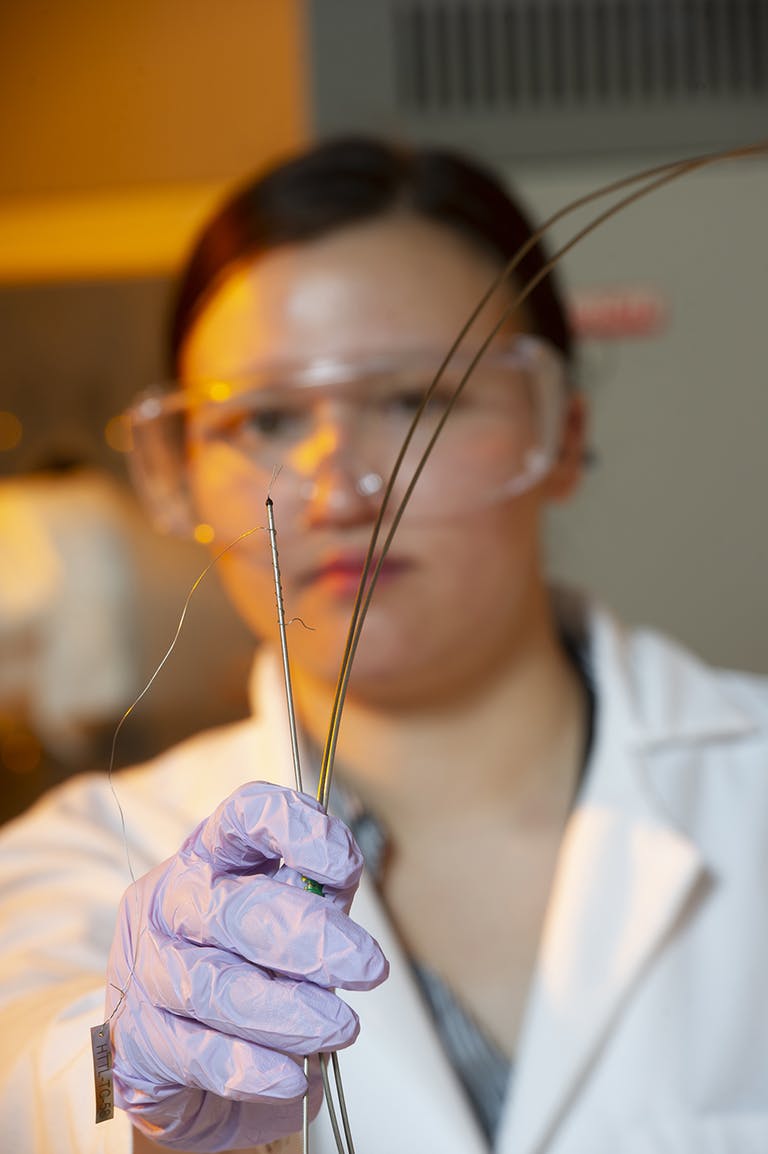by Forrest Burt
Ember Sikorski, fifth-year materials science and engineering doctoral student at Boise State, is passionate about a future powered with safe nuclear energy. “Even though nuclear is really safe, we’re continually building on this safety mentality to work toward greater public acceptance,” says Sikorski.
Sikorski’s research deals with a new type of nuclear fuel, uranium nitride, and getting a better understanding of its suitability as an improvement on existing fuels. Uranium nitride provides more power per unit volume and higher safety margins than existing fuels. Its properties also allow it to handle extreme heat, leading to a lessened likelihood of the fuel melting or damaging the cladding that contains it should an accident occur.

This research is powered by Boise State’s R2 and Borah compute clusters, as well as by the Idaho National Lab’s (INL) Sawtooth, Lemhi, and Falcon clusters. Sawtooth is currently recognized on the Top 500 list as the world’s 48th most powerful supercomputer; Lemhi and Falcon were formerly on the Top 500 list as well.
“Supercomputers are amazing because I run incredibly computationally expensive calculations. I use a model called ‘density functional theory,’ which not only models each atom, but the nucleus of the atom and the valence electrons around it. A sort of rule of thumb in my field is that for every atom you want to model, you need an entire processor dedicated to it, so if I want to model 100 atoms, I need 100 processors,” says Sikorski.
This computing access also helps with Sikorski’s other research focus, the development of improved temperature sensors for reactor interiors, in collaboration with experimentalists at INL where she has interned several times. Being able to work directly with INL researchers has given Sikorski a better understanding of how their sensors work and how best to communicate ideas and research concepts between theoretical and experimental science in her field.
“If you want to test different metals in a prototype, how do you do that? A vendor won’t build one single product when other people are ordering in bulk, so how do we build new prototypes? If an experimentalist wants to build out 20 different prototypes, instead of having to find different vendors to build all those, I can plug them all into a simulation and give them the few that work best so that they can just build those to try,” says Sikorski.
With her advisor, associate professor Lan Li, and Boise State’s continued partnership with INL, Sikorski is able to access Sawtooth, INL’s flagship, cluster to pursue this research.
“During my undergrad, I remember my advisors walking around the lab and telling everyone to shut down their calculations because we were about to hit our grant time on the supercomputer we were running on – and that is not a thing I’ve ever experienced at Boise State. It’s just not a problem here. You can submit as many calculations here as you want. It’s incredible to be in academia and get that kind of unlimited access. I can do crazy tests if I’m curious about something,” says Sikorski.
Sikorski believes that this kind of research capability is important for the future of clean energy on the planet and for decreasing reliance on fossil fuels.
“Since we’re running out of time to get our energy to carbon-free if we still want to survive on this planet, we don’t have time to run tests on our materials over long time scales. The reactors we have now have been running for 60 years – we don’t have time to do a test on a material over 60 years before we put it in a reactor. So the Nuclear Regulatory Committee is saying that if we can show them a model that actually works, then they’ll accept our modelling data to prove that this new fuel works,” says Sikorski.
Sikorski is set to graduate in May of 2021.
Learn More About Internships at INL or Using INL HPC Resources
Read more about INL internships and available HPC resources on the INL Intern web page and INL HPC web page. Email researchcomputing@boisestat.edu for more info about getting an account.
About Research Computing
Research Computing provides compute, storage, software, programming, and network solutions to help researchers do more of what they love—research! We collaborate with researchers across campus to troubleshoot and streamline their compute workflow; software; programming; and data wrangling, sharing, and storage challenges. Not sure if Research Computing services will help your research? Email us to schedule a one-on-one consultation to talk and read more about our services here: Services and Support.